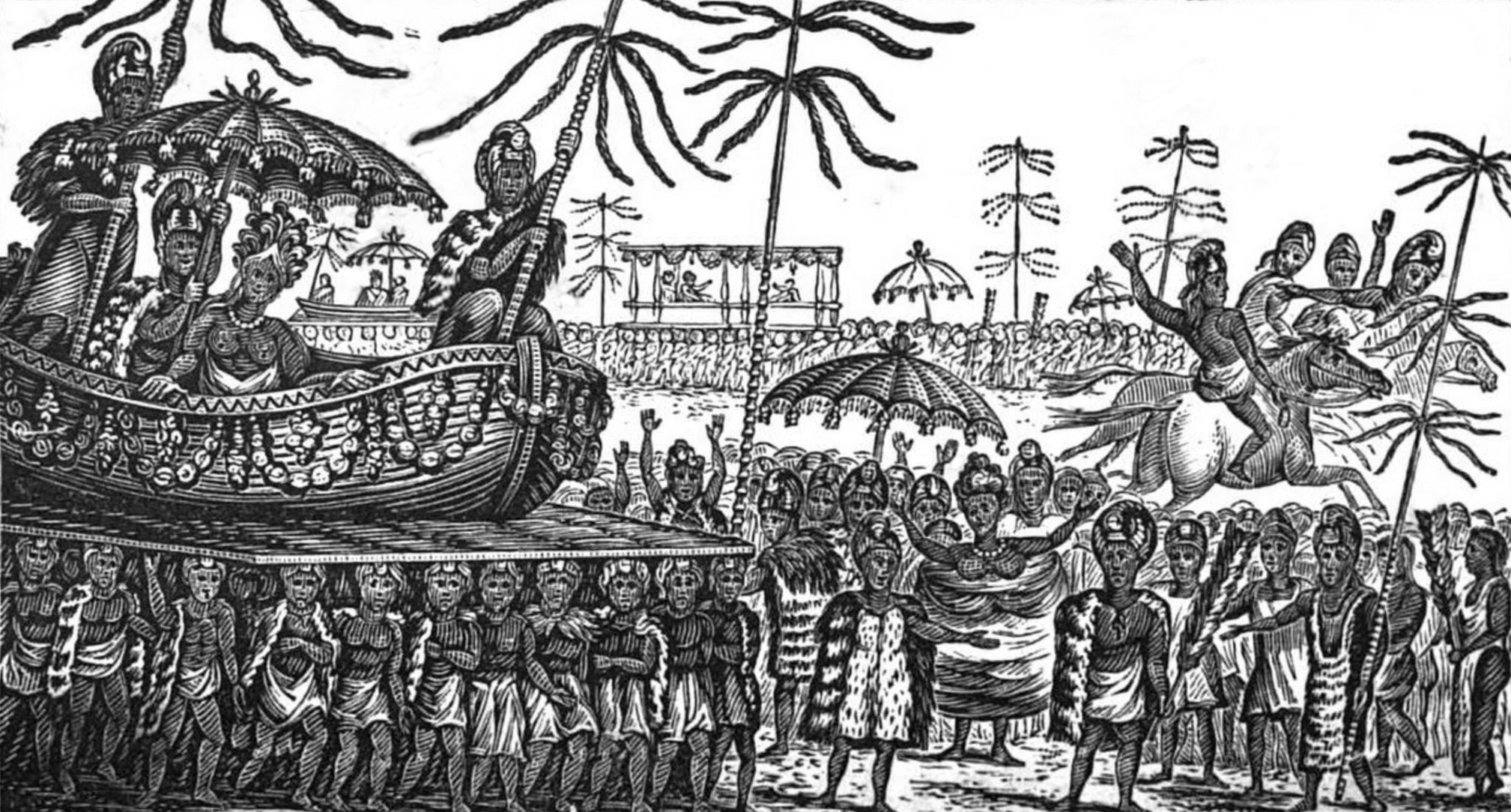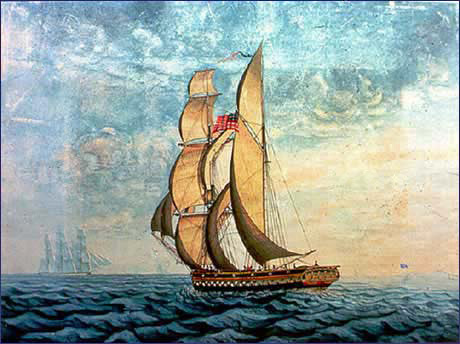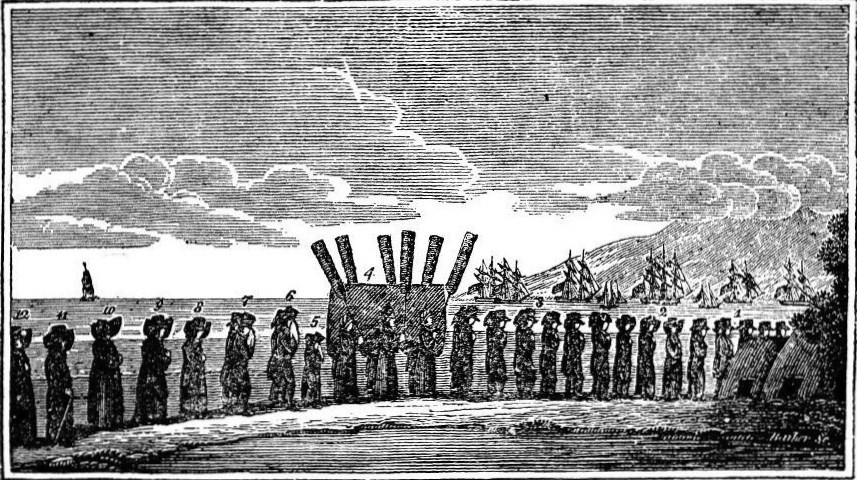|
Leleiohoku I
William Pitt Leleiohoku I (March 31, 1821 – October 21, 1848) was a Hawaiian noble during the Kingdom of Hawaii who married two notable princesses and served as Royal Governor of Hawaii island. Leleiohoku was born on March 31, 1821 in Kailua-Kona, Hawaii. He was the son of the Prime Minister Kalanimoku who was called ''The Iron Pillar of Hawaii'' and took the English name of William Pitt after British Prime Minister William Pitt the Younger. His mother was Kiliwehi, the daughter of King Kamehameha I. She named him in honor of the date of death of Kamehameha on the Hawaiian calendar, on the night of ''Hoku, Kaelo'' (May 14); ''Leleiohoku'' means ''"Fled in the time of Hoku"'' in the Hawaiian language. Other accounts give his mother as Kuwahine, who was another wife of Kalanimoku and a daughter of Governor Kaikioʻewa of Kauai and Piʻipiʻi Kalanikaulihiwakama, Kamehameha I's half-sister. He was considered of the highest hereditary descent after the king. He was ''hānai'' (adop ... [...More Info...] [...Related Items...] OR: [Wikipedia] [Google] [Baidu] |
Royal Governor Of Hawaii
The Governor of Hawaii Island ( haw, Kiaaina o na Mokupuni o Hawaii) was the royal governor or viceroy of the Island of Hawaii during the Kingdom of Hawaii. The Governor of Hawaii was usually a Hawaiian chief or prince and could even be a woman. There were no restriction of women in government in the House of Nobles or Governorship of the islands. The Governor had authority over the island of Hawaii, the biggest island in the kingdom, and it was up to the governor to appoint lieutenant governors to assisted them. The governor had replaced the old Aliʻis of the islands, but sovereignty remained with the king. The island governors were under the jurisdiction of the Ministers of the Interiors. Role The 1840 Constitution of the Kingdom of Hawaii states: Abolition After King Kalākaua was forced to sign the Bayonet Constitution in 1887, the island governorships began to be viewed as wasteful expenses for the monarchy. The governors and governesses at the time (who were mainly ro ... [...More Info...] [...Related Items...] OR: [Wikipedia] [Google] [Baidu] |
Hānai
''Hānai'' is a term used in the Hawaiian culture that refers to the informal adoption of one person by another. It can be used as an adjective, such as "''hānai'' child", or as a verb to ''hānai'' someone into the family. In the Hawaiian culture, ''hānai'' has historically been a practice of one family ''hānai''-ing their child into another family. It has made tracing genealogical roots somewhat more complicated. When Winona Beamer spoke about the issue of ''hānai'' and its relevance to admission at Kamehameha Schools, she had first-hand knowledge of the practice in her immediate family. Kaliko Beamer-Trapp was born in England, but emigrated to the United States with his biological mother. When Beamer decided to ''hānai'' Kaliko into her family, it was with a special ''hānai'' ceremony. Other Polynesian cultures, such as the Tahitians and Māori Māori or Maori can refer to: Relating to the Māori people * Māori people of New Zealand, or members of that group * Māo ... [...More Info...] [...Related Items...] OR: [Wikipedia] [Google] [Baidu] |
Legislature Of The Hawaiian Kingdom
The Legislature of the Hawaiian Kingdom () was the bicameral (later unicameral) legislature of the Hawaiian Kingdom. A royal legislature was first provided by the 1840 Constitution and the 1852 Constitution was the first to use the term Legislature of the Hawaiian Islands, and the first to subject the monarch to certain democratic principles. Prior to this the monarchs ruled under a Council of Chiefs (ʻAha Aliʻi). Structure The Legislature from 1840 to 1864 was bicameral and originally consisted of a lower House of Representatives and an upper House of Nobles as provided for under the Constitutions of the Kingdom of 1840 and 1852, until abolished by the 1864 Constitution which then provided for a unicameral Legislature. House of Nobles The members of the upper House of Nobles (Hale ʻAhaʻōlelo Aliʻi) were appointed by the Monarch with the advice of his Privy Council. It also served as the court of impeachment for any royal official. Members were usually Hawaiian ali� ... [...More Info...] [...Related Items...] OR: [Wikipedia] [Google] [Baidu] |
Kekūanāoʻa
Mataio Kekūanaōʻa ( – November 24, 1868), formally referred to as His Honor or His Highness, was a Hawaiian politician who served as governor of the island of Oahu, father of two kings, Kamehameha IV and Kamehameha V, and held the office of Kuhina Nui as did his wife, Kīnaʻu and their daughter, Victoria Kamāmalu. His first name is the Hawaiian form of Matthew. Kekūanaōʻa translates as "the standing projection" in the Hawaiian language. Parentage and early life Kekūanaōʻa was born sometime around the year 1791. His mother is believed to be Inaina. While an obituary at his death identified his father as Nāhiʻōleʻa, on March 14, 1879 the Hawaiian Supreme court identified Kiʻilaweau as the father of Kekuanaoa in probate using the genealogy books of the royal family, proving a legal bloodline line from Keʻelikōlani back to Kiʻilaweau's grandmother, Moana. John Papa ʻĪʻī's uncle Nāhiʻōleʻa, the aliʻi that took Kalanikapule's side against Kamehameha I a ... [...More Info...] [...Related Items...] OR: [Wikipedia] [Google] [Baidu] |
Kalanipauahi
Pauahi (c.1804–1826) was a member of the royal family of the Kingdom of Hawaii in the House of Kamehameha. Referred as Pauahi in her lifetime, she is often referred to as Kalanipauahi or Kalani Pauahi to differentiate her from her niece and namesake Bernice Pauahi Bishop. Life Pauahi was born circa 1804. Her mother was Keouawahine, daughter of Kauhiwawaeono of Maui by his wife, chiefess Loe-wahine, who in turn was daughter of Kameeiamoku. Her father was the High Chief Pauli Kaʻōleiokū (1767–1818). The name ''Pauahi'' originated in an incident which occurred in her childhood. By an accidental explosion of gunpowder she narrowly escaped being burned to death. Five men were killed in the catastrophe, her mother house was burned to the ground, and she was badly injured. In commemorating her escape she was given the name Pauahi, which is composed of two Hawaiian words, ''pau'', "finished", or "completed" and ''ahi'', "fire", which, when translated, means "the fire is out". ... [...More Info...] [...Related Items...] OR: [Wikipedia] [Google] [Baidu] |
Keʻelikōlani
Ruth Ke‘elikōlani, or sometimes written as Luka Ke‘elikōlani, also known as Ruth Ke‘elikōlani Keanolani Kanāhoahoa or Ruth Keanolani Kanāhoahoa Ke‘elikōlani (June 17, 1826 – May 24, 1883), was a formal member of the House of Kamehameha (founding dynasty of the Hawaiian Kingdom), Governor of the Island of Hawaiʻi and for a period, the largest and wealthiest landowner in the Hawaiian islands. Keʻelikōlani's genealogy is controversial. Her mother's identity has never been in question but her grandfather Pauli Kaōleiokū's relationship to Kamehameha I is heavily disputed. While her father has been legally identified as early as 1864, disputes to that lineage continued as late as 1919. As one of the primary heirs to the Kamehameha family, Ruth became landholder of much of what would become the Bernice Pauahi Bishop Estate, funding the Kamehameha Schools. Her name Keʻelikōlani means ''leaf bud of heaven''. Birth, family and early life Keʻelikōlani's mother wa ... [...More Info...] [...Related Items...] OR: [Wikipedia] [Google] [Baidu] |
Kamehameha II
Kamehameha II (November 1797 – July 14, 1824) was the second king of the Kingdom of Hawaii. His birth name was Liholiho and full name was Kalaninui kua Liholiho i ke kapu ʻIolani. It was lengthened to Kalani Kaleiʻaimoku o Kaiwikapu o Laʻamea i Kauikawekiu Ahilapalapa Kealiʻi Kauinamoku o Kahekili Kalaninui i Mamao ʻIolani i Ka Liholiho when he took the throne. Early life Kamehameha II was born in the month of Hanaiaʻeleʻele (corresponding to November) 1797 in Hilo, on the island of Hawaiʻi, the first born son of Kamehameha I with his highest-ranking wife Keōpuolani. It was originally planned that he would be born at the Kūkaniloko birth site on the island of Oʻahu but the Queen's sickness prevented travel. Given in care to his father's trusted servant Hanapi, who took the child to rear him in the lands of Kalaoa in Hilo Paliku, he was taken back, after five or six months, by his maternal grandmother Kekuʻiapoiwa Liliha because she felt he was not getting ... [...More Info...] [...Related Items...] OR: [Wikipedia] [Google] [Baidu] |
Kekauʻōnohi
Keahikuni Kekauʻōnohi (c. 1805–1851) was a Hawaiian high chiefess who was a member of the House of Kamehameha. She was granddaughter to King Kamehameha I and one of the wives of Kamehameha II. Her Christian name is disputed; it is given as Mikahela in the 1848 Mahele Book and as Miriam in later sources. Biography She was born circa 1805 at Lahaina, Maui. Her father was Kahōʻanokū Kīnaʻu. Her mother was Kahakuhaʻakoi Wahinepio, sister of Boki and Kalanimoku and granddaughter of Alii Nui, Kekaulike of Maui. Her father was a son of Kamehameha I and his wife Peleuli, daughter of Kamanawa, one of the royal twins. She married her uncle Kamehameha II. She was one of his five wives. Others were Kamāmalu, Pauahi, Kīnaʻu, and Kekāuluohi. She was the youngest, but Kamāmalu was Liholiho's favorite. She was at the famous meal when the '' kapu'' system was overturned in 1819, known as the ʻAi Noa. After Liholiho's death in London, she went to Kauaʻi to live with her ... [...More Info...] [...Related Items...] OR: [Wikipedia] [Google] [Baidu] |
Waiola Church
Waiola Church is the site of a historic mission established in 1823 on the island of Maui in Hawaii. Originally called Wainee Church until 1953, the cemetery is the final resting place for early members of the royal family of the Kingdom of Hawaii. History The first mission to Maui was founded by Reverend William Richards (1793–1847) in 1823. For a few years, temporary structures made from wooden poles with a thatched roof were used. In 1828, island Governor Hoapili supported the building of a stone and wood structure. The Christian church was built adjacent to a pond surrounding an island called Mokuula, which was sacred to traditional Hawaiian religion and residence of the king. The first stone building was dedicated on March 4, 1832 and called Wainee Church. Rev. Ephraim Spaulding (1802–1840) joined with his wife Juliet Brooks (1810–1898) from 1832 to 1836. Rev. Dwight Baldwin transferred here in 1836, and served as physician, even though trained in theology. The Bald ... [...More Info...] [...Related Items...] OR: [Wikipedia] [Google] [Baidu] |
Kamehameha III
Kamehameha III (born Kauikeaouli) (March 17, 1814 – December 15, 1854) was the third king of the Kingdom of Hawaii from 1825 to 1854. His full Hawaiian name is Keaweaweula Kīwalaō Kauikeaouli Kaleiopapa and then lengthened to Keaweaweula Kīwalaō Kauikeaouli Kaleiopapa Kalani Waiakua Kalanikau Iokikilo Kīwalaō i ke kapu Kamehameha when he ascended the throne. Under his reign, Hawaii evolved from an absolute monarchy to a constitutional monarchy with the signing of both the 1840 Constitution, which was the first Hawaiian Language Constitution, and the 1852 Constitution. He was the longest reigning monarch in the history of the Kingdom, ruling for 29 years and 192 days, although in the early part of his reign he was under a regency by Queen Kaahumanu and later by Kaahumanu II. His goal was the careful balancing of modernization by adopting Western ways while keeping his nation intact. Early life Kauikeaouli was born at Keauhou Bay, on Hawaii island, the largest isla ... [...More Info...] [...Related Items...] OR: [Wikipedia] [Google] [Baidu] |
Nahienaena
Harriet or Harrieta Keōpūolani Nāhiʻenaʻena (1815–1836) was a high-ranking princess during the founding of the Kingdom of Hawaii and the conversion of some of the ruling class to Christianity. Life In the Hawaiian language ''nā ahi ʻena ʻena'' means "the red-hot raging fires". Nāhiʻenaʻena was born in 1815 at Keauhou Bay, South Kona, island of Hawaiʻi. Her parents were Kamehameha I and Keōpūolani, the Queen consort. She had two older brothers, ''hiapo'' (first born) Liholiho, and Kauikeaouli, who later became Kings Kamehameha II and III. Nāhiʻenaʻena was the sacred ''muli loa'' (last born) child, and was trained for the immense ''kuleana'' (privilege and responsibility) that would accompany someone of such high birth. In 1825, the ship returned with the bodies of King Kamehameha II and the Queen Kamāmalu, who had died on a trip to London. Ship's artist Robert Dampier painted a portrait of the ten-year-old princess, dressed in a red feather cloak for t ... [...More Info...] [...Related Items...] OR: [Wikipedia] [Google] [Baidu] |
Christianity
Christianity is an Abrahamic monotheistic religion based on the life and teachings of Jesus of Nazareth. It is the world's largest and most widespread religion with roughly 2.38 billion followers representing one-third of the global population. Its adherents, known as Christians, are estimated to make up a majority of the population in 157 countries and territories, and believe that Jesus is the Son of God, whose coming as the messiah was prophesied in the Hebrew Bible (called the Old Testament in Christianity) and chronicled in the New Testament. Christianity began as a Second Temple Judaic sect in the 1st century Hellenistic Judaism in the Roman province of Judea. Jesus' apostles and their followers spread around the Levant, Europe, Anatolia, Mesopotamia, the South Caucasus, Ancient Carthage, Egypt, and Ethiopia, despite significant initial persecution. It soon attracted gentile God-fearers, which led to a departure from Jewish customs, and, a ... [...More Info...] [...Related Items...] OR: [Wikipedia] [Google] [Baidu] |
.jpg)




_-_Kamehameha_III%2C_1825.jpg)
%2C_Nahiennaena_(1825).jpg)